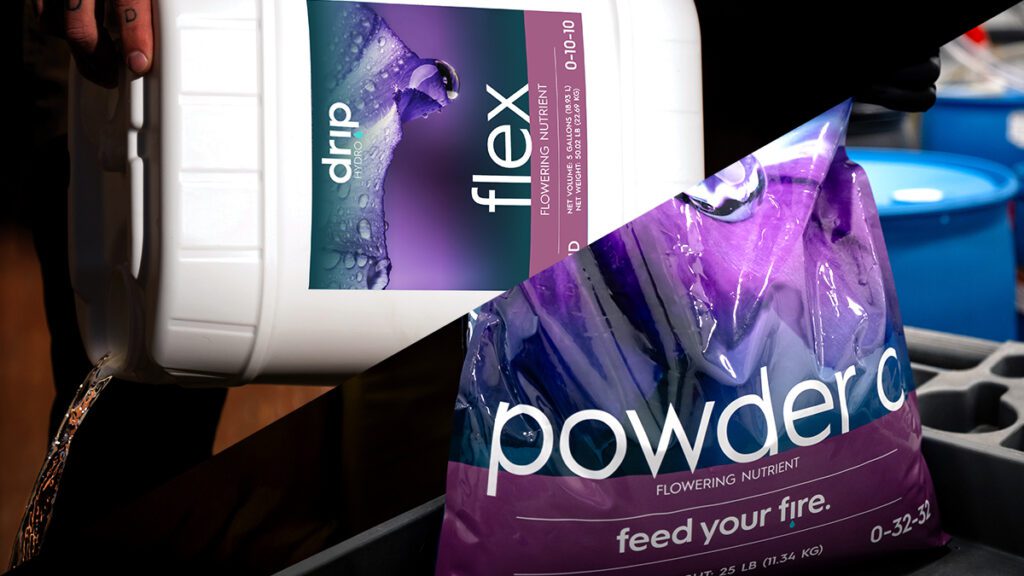A frequent question from growers using the FLUID line is
“How do I properly supplement with POWDER parts?”
Both FLUIDS and POWDERS are complete nutrient systems on their own, but if you choose to blend, here’s the precise method—backed by real numbers—so you maintain balance and consistency.
Why Growers Blend
- Expanded PK options via gram-level control
- Late-flower nitrogen taper with full trace-element support
- Targeted micronutrient replacement when cutting Base A
1. Matching Flex with Powder C
Scenario: Flex at 1 mL per gallon working strength. Flex density is 1.199 g/mL, guaranteed at 10 % P₂O₅ and 10 % K₂O by weight.
- Mass of P₂O₅ per mL Flex
1.199 g × 10 % = 0.1199 g P₂O₅
(same for K₂O) - Powder C strength
32 % P₂O₅ and 32 % K₂O → 0.32 g P₂O₅ per 1 g powder - Powder C needed
0.1199 g ÷ 0.32 = 0.375 g Powder C per gallon feed
Quick Conversion
| Flex (mL/gal) | Powder C (g/gal) |
|---|---|
| 1 | 0.375 |
| 2 | 0.749 |
| 3 | 1.124 |
2. Tapering Base A with Powder D
When you reduce Base A in late flower you lose its nitrogen, calcium and trace elements. Base B remains constant so Powder D only replaces what Base A provided.
Base A density: 1.198 g/mL
Late-flower Base A dose: 6 mL/gal → 6 × 1.198 = 7.188 g
2.1 Micros Removed per Gallon
| Element | % in Base A | Mass removed (g) |
|---|---|---|
| Iron (Fe) | 0.03 % | 7.188 × 0.0003 = 0.002156 |
| Manganese | 0.01 % | 0.000719 |
| Copper | 0.008 % | 0.000575 |
| Zinc | 0.004 % | 0.000288 |
| Molybdenum | 0.0002 % | 0.000014 |
Iron is highest at 0.002156 g per gallon.
2.2 Powder D strength
8.13 % Fe by weight → 0.0813 g Fe per 1 g Powder D
2.3 Full-replacement rate
0.002156 g ÷ 0.0813 = 0.0265 g Powder D per gallon
2.4 Taper Schedule
| Week | % Base A removed | Powder D (g/gal) | Powder D (mL/gal)† |
|---|---|---|---|
| Week 6 | 50 % | 0.0133 | 1.26 |
| Week 7 | 75 % | 0.0199 | 1.88 |
| Weeks 8–9 | 100 % | 0.0265 | 2.51 |
†Assumes Powder D stock of 40 g per gallon (≈ 3785 mL)
Calcium Support
Base A also supplies calcium (4.5 %). If you taper:
- Add 0.3 g/gal Powder A or
- Add 0.6 mL/gal CaMg (10 % Ca)
Mixing Best Practices
- Mix powders first: A + D, then C, then add Base B
- Never combine calcium and phosphate powders in the same stock barrel
- Stir 10–15 minutes and let rest for full dissolution
- Monitor drain EC and pH for three feeds after changes
- Adjust Powder C ± 0.05 g/gal or Powder D ± 0.002 g/gal if needed
Final Notes
Blending FLUIDS and POWDERS gives you extra flexibility. Powder C provides gram-level PK control. Powder D replaces exactly the micros lost when tapering Base A. With these calculations you’ll keep your nutrient program balanced, clear and consistent.
Want detailed feeding schedules or further support? Visit driphydro.com or reach out to our team for custom guidance.


